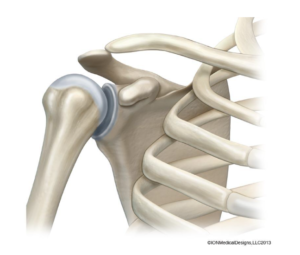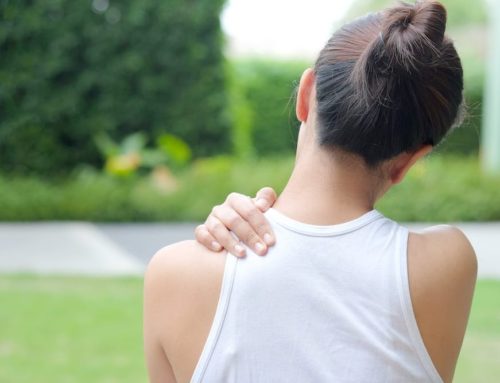Are you suffering with shoulder pain?
Are you frustrated that you cannot do the things you want to do?
Have you tried every treatment recommended by friends, family & the internet?
Have you been told it’s just “old age” or that you’ll just have to live with it?
If so, you’ve come to the right place.
Today we are going to be talking to you about some of the causes of shoulder pain, and we want to encourage you that there is hope for you – no matter how long your shoulder has been bothering you, there are things that can be done to bring you relief without surgery.
Shoulder Anatomy
The shoulder girdle is made up of 3 components:
- The glenohumeral joint – which is a ball & socket joint where the head of the humerus (arm bone) meets the glenoid fossa (or socket) on the scapula (shoulder blade). This is the primary joint you think of as the shoulder joint.
- The AC, or acromioclavicular, joint – this is what attaches the shoulder to the rest of the body. It is comprised of the clavicle (or collarbone) which attaches to the sternum (or breastbone) and the acromion, which is the upper portion of the scapula (shoulder blade).
- The scapulothoracic joint – this is not a true joint but it functions as a joint. It is made up of the scapula (shoulder blade) which floats over the ribcage (located in the thoracic region).
There are many muscles in the shoulder which work together to give the shoulder joint stability and mobility. The rotator cuff is a group of 4 muscles that arise from the front and back of the scapula (shoulder blade) and attach on the head of the humerus. These are the primary stabilizers of the shoulder – keeping the head of the humerus properly positioned within the joint, enabling proper movement and functional use of the arm.
Shoulder Dysfunctions
The most common dysfunctions resulting in shoulder pain are frozen shoulder and rotator cuff impingement. A frozen shoulder is a limitation of shoulder range of motion due to restricted mobility within the capsule of the glenohumeral joint, which is also called adhesive capsulitis.
Rotator cuff impingement is a pinching of the rotator cuff muscles as they pass under the acromion that occurs when the arm is lifted. Most of you have heard of the different “itis”-es of the shoulder – tendinitis, bursitis, or arthritis.
The suffix “itis” means “inflammation of” so tendinitis is inflammation of a tendon, bursitis is inflammation of a bursa (a cushioning sac found within the shoulder and many other areas of the body), and arthritis is inflammation of a joint due to breakdown of the cartilage on the ends of the bones within the joint.
These may be present and painful, but these are just signs that the shoulder is not functioning properly and are rarely the root cause of the pain. This is where meeting with an expert in shoulder pain can be helpful in finding and treating the root cause of your pain.
Root Causes of Shoulder Pain
Posture:
Shoulder pain can be caused by something as simple as poor posture. With proper posture, the uppermost point of the shoulder should be in line with the ear, hip and knee and ankle. Slouched posture tilts the shoulder blade forward, causing the head to jut forward and the shoulders to round forward. Try sitting up straight with proper posture and raise your arms overhead as far as you can. Now try raising both arms in a slouched posture. You can see that the range of motion is significantly reduced in the slouched position so improving your posture is an important part of treating your shoulder pain.
Weakness of the rotator cuff muscles and scapular stabilizers:
Weakness may be caused by an injury, a systemic disease or failure to use a muscle consistently. Much of what we do with our arms is in front of us, especially with the increasing tendency to be sedentary as we age or discontinue sporting activities. We often fail to use the muscles on the back side of our shoulders and upper back. This leads again to poor posture, allows the head of the humerus to ride up in the glenoid (socket) and can cause impingement of the rotator cuff tendons under the acromial arch – which simply means the tendons get pinched when the arm is lifted, resulting in shoulder pain and limited movement.
Loss of ROM (range of motion):
Could be caused by an injury, arthritic changes in the joint or immobilization after surgery – especially common after breast surgeries – that can result in the joint capsule “freezing up” which is called a frozen shoulder.
Overuse:
Shoulder pain is often caused by overuse injuries – this could be a repetitive motion such as repeated pushing or pulling, throwing or even using a computer mouse for prolonged periods. This can strain the shoulder muscles over time which can result in weakness and tendonitis, impingement, and eventually rotator cuff tears.
As you can see, there are many factors that lead to shoulder pain so it is rarely a quick fix, but be assured that with the right treatment, there is hope for relief of pain and return to function when these factors are addressed. One of our shoulder experts would be happy to meet with you to evaluate your shoulder pain to find & address the specific issues that are causing you pain so that you can get back to doing the things you want to do.

























































